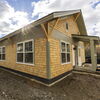MEREDA spring real estate index: Commercial declines; residential, construction strong
 Photo / Tim Greenway
Richard Brescia, vice president of Cianbro Corp., which built the new WEX headquarters. The building, at right, was cited in the said in MEREDA's 2019 spring index as one of the examples of Portland development that's having an impact on commercial prices.
Photo / Tim Greenway
Richard Brescia, vice president of Cianbro Corp., which built the new WEX headquarters. The building, at right, was cited in the said in MEREDA's 2019 spring index as one of the examples of Portland development that's having an impact on commercial prices.
There are fewer sales, fewer leases and less square footage involved in Maine commercial real estate over the past six months, but residential and construction are going strong, according to the Maine Real Estate and Development Association.
MEREDA cited the finding as part of its annual spring index, which was released at the association's 2019 Spring Conference, held Tuesday in Portland. The index is compiled from data collected by the Maine Association of Realtors, The Boulos Co., Maine Department of Labor, Mortgage Bankers Association, U.S. Census and Moody's Analytics.
The index was presented at the conference by Charles Colgan, professor emeritus of public policy and planning and a senior research advisor for the Maine Center for Business and Economic Research at the University of Southern Maine.
Commercial real estate
The commercial index includes data on transactions, commercial square footage, commercial sales price per square footage and lease rates per square foot.
The commercial market recovered to pre-recession levels in 2013, and peaked in the second quarter of 2016, according to Porta & Co.'s Joseph Porta, who put together the commercial index. "Since then, the volume of transactions and the total volume of building square feet leased and sold has been declining."
Notable numbers over the last six months:
- Sale and lease transactions are down 13%;
- Square foot totals sold and leased are down 41%, though Porta noted that this component is the most volatile quarter to quarter;
- Commercial sales price per square foot is down nearly 10% after rising 3% in the last quarter of 2018;
- Lease prices have risen 25% over the past year, particularly in the first quarter of 2019.
He said after eight years of economic expansion and historically low interest rates, capitalization rates have dipped under 7% for the stronger commercial assets in southern Maine. "This has produced soaring valuations with pricing at or above replacement cost."
He said investors are managing risk by prioritizing value over short-term cash flow, and those developing new Class A office space are using tax advantages "effectively opening pathways where new construction is a plausible solution."
The underlying driver of the market growth, Porta said, is "the sustained expansion of Portland's downtown and greater metropolitan statistical area."
He forecast a continued shift in emphasis onto rate of return in the next two quarters, and "deployment of investment capital with the patience to utilize time in order to reach underwriting objectives."
Residential real estate
Elise Kiely, senior vice president of Legacy Properties, who presented the residential index, wrote: "In contrast to the commercial component, the residential component is showing a strong market."
The residential index is based on building permits, mortgage originations, median price and existing units.
She said that Maine's residential market in 2019 started off with relatively low inventory and strong demand.
"Volume of units sold may be lower in some sectors due to lack of inventory, but we are seeing some increases in sales prices," she said. "Properties in good condition and appropriately price are seeing multiple offers with sale prices at or above list price."
She also said hiring at several large companies in the Portland area, including WEX, Covetrus, IDEXX, Tilson and Tyler Technologies, is a "key driver to healthy command" in the residential market.
Number for the last six months include:
- Sales of existing units are down 4.3%;
- Building permits for single and multi-family homes are up 6.5%;
- Mortgage originations are up 8.5%.
The biggest challenge is affordability, both with new construction development and workforce housing, Kiely said.
"In order to sustain the golden goose of the food and craft brewery economic drivers for the area, we need to ensure affordable housing for the people serving in these fields," she said. "The real challenge in addressing the affordable housing need is doing it in a strategic and effective way that encourages the private sector to have a voice in the solution.
Construction
In construction, "The index value at the end of the first quarter is the highest value since the depth of the recession in the fourth quarter of 2009," wrote Richard Brescia, vice president of Cianbro Corp.
Brescia said there is strong demand, including increased interest and investment from outside the state.
"What's more, the demand wasn't concentrated in our largest metropolitan markets, but stretched statewide, putting added pressure on construction resources and — subsequently — costs."
The driving forces behind increased costs are tied to supply and demand, with contractors and subcontractors "extremely busy." The skilled labor shortage and worldwide economy uncertainty because of trade agreements and commodity tariffs.
"Considering that budgets for today's construction projects may have been developed a year or two years ago, the cost increases are sobering for owners," Brescia said.
He said contractors can mitigate that by employing creative solutions like lean construction principals, using just-in-time material deliveries, modular components, and more; and collaborative management, where owner, design and construction firms work together from the conceptual stage through completion.
He said the design and budgeting process would allow real-time pricing at each design stage, and changes that meet quoted prices.












0 Comments